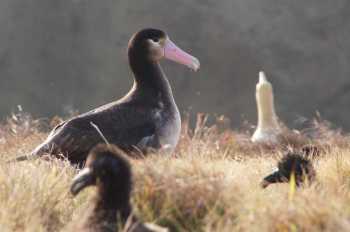The first translocated Short-tailed Albatross Phoebastria albatrus to return to the site of the artificial colony on Mukojima Island was Red Y01, thought to be a male. It was first seen on 10 February 2011 where it was photographed interacting with the 2011 chicks translocated from Torishima and with the decoy models (see photograph below). The bird had fledged on 20 May 2008 from the first translocated cohort, so it had returned in less than three years (click here).
Red Y01 is now back again on Mukojima, being seen on 5 December at the colony site. The fact that it has returned earlier this breeding season than during the last suggests it is both maturing and becoming well-habituated to the site, lending hope that it will in time breed there, thus creating a new breeding colony for the species.

Red Y01 on Mukojima earlier this year: now back again
Photograph by Tomohiro Deguchi
Search on "Mukojima" to read earlier items posted to ACAP Latest News on this endeavour to create a new breeding colony of Short-tailed Albatrosses on a non-volcanically active island, now part of a World Heritage Site.
With thanks to Tomohiro Deguchi, Yamashina Institute for Ornithology for information.
John Cooper, ACAP Information Officer, 7 December 2011

 English
English  Français
Français  Español
Español